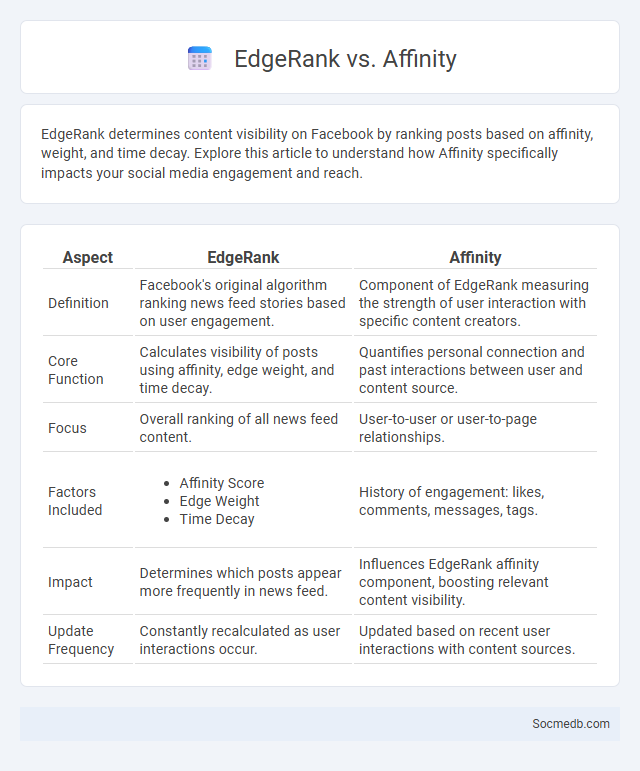
Photo illustration: EdgeRank vs Affinity
EdgeRank determines content visibility on Facebook by ranking posts based on affinity, weight, and time decay. Explore this article to understand how Affinity specifically impacts your social media engagement and reach.
Table of Comparison
| Aspect | EdgeRank | Affinity |
|---|---|---|
| Definition | Facebook's original algorithm ranking news feed stories based on user engagement. | Component of EdgeRank measuring the strength of user interaction with specific content creators. |
| Core Function | Calculates visibility of posts using affinity, edge weight, and time decay. | Quantifies personal connection and past interactions between user and content source. |
| Focus | Overall ranking of all news feed content. | User-to-user or user-to-page relationships. |
| Factors Included |
|
History of engagement: likes, comments, messages, tags. |
| Impact | Determines which posts appear more frequently in news feed. | Influences EdgeRank affinity component, boosting relevant content visibility. |
| Update Frequency | Constantly recalculated as user interactions occur. | Updated based on recent user interactions with content sources. |
Introduction to Facebook’s Ranking Algorithms
Facebook's ranking algorithms analyze billions of interactions daily to prioritize content that matches Your interests and engagement patterns. By evaluating factors such as relevancy, post type, and timeliness, these algorithms decide which posts appear prominently on Your News Feed. This personalized approach ensures You see meaningful content while minimizing irrelevant or low-quality posts.
What is EdgeRank?
EdgeRank is the algorithm Facebook uses to determine which posts appear in your News Feed, prioritizing content based on affinity, weight, and time decay factors. It evaluates your interactions with friends, pages, and groups to rank posts that are most relevant to you. Understanding EdgeRank helps maximize your content's visibility by aligning with Facebook's engagement criteria.
Understanding Affinity in Social Media Algorithms
Affinity in social media algorithms measures the strength of the relationship between users and content creators, influencing which posts appear prominently in users' feeds. Platforms like Facebook and Instagram analyze interactions such as likes, comments, shares, and direct messages to determine affinity scores, prioritizing content from users with higher engagement levels. Optimizing content to increase user affinity boosts visibility, enhances reach, and drives meaningful engagement on social media platforms.
The Evolution of EdgeRank: Past to Present
EdgeRank, Facebook's original algorithm, prioritized content based on affinity, weight, and decay to determine what appeared in users' News Feeds, shaping the early social media experience. Over time, it evolved into a more complex machine learning system considering hundreds of factors like user behavior, content type, and post timeliness to enhance relevance and engagement. Understanding this evolution helps you optimize your social media strategy by tailoring content that aligns with current algorithm priorities.
Core Components of EdgeRank Explained
EdgeRank, the algorithm that determines the visibility of your posts on social media, is mainly composed of three core components: affinity, weight, and time decay. Affinity measures the relationship strength between you and other users, increasing the likelihood that your content appears on their feed. Weight assigns importance to different types of interactions, such as comments or shares, while time decay reduces the visibility of older posts to keep content fresh and relevant.
How Affinity Influences Content Visibility
Affinity plays a crucial role in determining how social media algorithms prioritize and display content based on your interactions with other users. Your regular engagement with specific profiles signals to platforms that you value their content, increasing the likelihood that their posts will appear prominently in your feed. Understanding affinity helps you tailor your content strategy to enhance visibility and foster stronger audience connections.
EdgeRank vs Affinity: Key Differences
EdgeRank is the original algorithm Facebook used to determine which posts appear in Your News Feed by evaluating factors such as affinity, weight, and time decay. Affinity measures the relationship strength between You and other users or content, influencing how likely posts are shown in Your feed based on interaction history. Understanding the key differences between EdgeRank's comprehensive scoring and Affinity's focus on user connections helps optimize content visibility on social media platforms.
Modern Facebook News Feed Algorithm: Beyond EdgeRank
The modern Facebook News Feed algorithm incorporates machine learning techniques to prioritize content based on user interactions, relevance, and recency rather than relying solely on the outdated EdgeRank system. It evaluates hundreds of signals such as user engagement patterns, content type, and video watch time to personalize feeds uniquely for each user. This approach ensures higher-quality, meaningful interactions and helps prioritize posts from friends, family, and pages users engage with most frequently.
Impact of Ranking Factors on Organic Reach
Ranking factors such as engagement rates, content relevance, and post frequency significantly influence organic reach on social media platforms. Algorithms prioritize posts that generate high user interaction, meaning Your content's visibility depends on attracting likes, comments, and shares. Optimizing for these ranking signals increases organic reach, enhancing Your overall social media impact.
Optimizing Content Strategy for Maximum Visibility
Optimizing content strategy for maximum visibility on social media involves leveraging targeted keywords, analyzing platform-specific algorithms, and posting at peak engagement times to enhance reach and interaction. Incorporating diverse formats like videos, stories, and carousel posts increases audience retention and boosts algorithmic favorability. Consistent monitoring of analytics tools enables data-driven adjustments, improving content relevance and amplifying organic growth across channels such as Instagram, Facebook, and LinkedIn.
 socmedb.com
socmedb.com